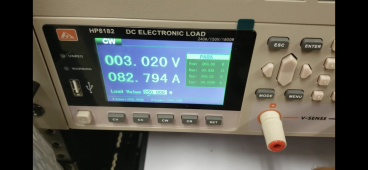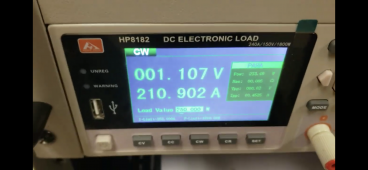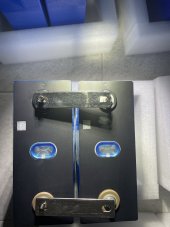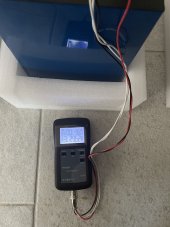Clarification please:
1) Are these being tested just out of the shipping box ?
2) Have you Top Charged the cells prior to testing.
NB) Cells are shipped at nominal voltage of 3.200 because it is ideal for storage. Reading IR at this state means little. SADLY many vendors in China call their cells Matched because they Voltage & IR test with a YR1035+ or similar at their static storage voltage, which is fairly useless.
Top Charge: Similar to top balancing cells in parallel. Charge to 3.650 and allow the cells to take charge to 0.05C (at minimum) but I let CV continue till the cells take <2A. Then allow to settle 24-36 hours and re-top, allow to settle 2 hours and test ? You would have to do this before running a cell capacity test.
Properly Matched & Batched cells go through a full charge to discharge cycle 3 times. Measurements are taken through the Discharge & Charge cycle at various C Rates and logged. Upon completion cells that match IR & Impedances across their operational voltages are then batched together. This is a time-consuming costly process that can add up to 50% above the cost "Bulk Commodity Cells" which many vendors sell as Voltage & IR Matched.
BE AWARE that using Bulk Commodity cells in parallel can result in various problems and issues. They will often have "runners" which will either reach 3.650Vpc well ahead of the others or reach 2.500 before the others. Bulk cells can deviate by as much as 1mv per AH of capacity which can also trigger a Cell Difference cutoff. So a 300AH cell can deviate as much as 300mv, this is NOT good. The higher the Amperage is (Charge or Discharge) the faster & greater the deviation. ALSO, with Bulk Cells it is more noticeable, when a Large Load surge hits the battery pack, the cells will take a sag of course BUT you will see the lower IR cells will sag deeper & take longer to recover. There is a BMS GOTCHA there ! All BMS' have a CUTOFF DELAY TIME (or similarly worded) which can be increased slightly to allow for hard dips & recovery time, I have found that 10 seconds is sufficient... This was all discovered during my Thrash Test cycle which was Hard Reliability & Performance testing of the entire system including some "controlled abuse"
Once packs are assembled and ready to go after a proper Top Balancing, you can run them as normal.
Do not be aggressive with charging and keep a respectable charge profile. Be aware that above 3.500 and below 2.875 only represents about 5% of the actual energy stored. The working Voltage is 3.000-3.400 with the nominal being 3.200.
Here is my Solar Controller charge profile, this will reduce the amount of HVD's by preventing runners from getting carried away. The Float being CV allows all the cells to top off & balance quite comfortable without stress
All equipment MUST BE Voltage Corrected & Calibrated (VERY IMPORTANT) see link in my signature on how to do it.
Divide Values X2 for 12V. Multiply X2 for 48V.
Absorb: 28.2 for 15 minutes (3.525vpc) (some call this boost)
Equalize: OFF
Float 27.9V (3.4875vpc)
MIn Volts: 22.0 (2.750vpc)
Max Volts: 28.7 (3.5875vpc)
Rebulk Voltage: 27.7 (3.4625vpc)
End Amps: 14A (*1)
(*1): End Amps is calculated from the Highest AH Battery Pack in a Bank. IE: 200AH X 0.05 = 10A 280AH X 0.05 = 14A.
NB: Victron Forum discussion says EndAmps = TailCurrent
This get's the bank charged to full with high amps (Constant Current) and then float (Constant Voltage) tops off so the cells are on average between 3.475-3.500. I am running 7/24/365 so float is used up by the Inverter + provides whatever the packs will take to top off.
** Coulumbic Efficiency for LFP is 99%
Now a piece of Sad News:
Matched Grade-A cells always test out higher than the rating. EVE Matched 280's for example always come in between 288-295AH, the same cells but bulk always come in between 275-282AH barely and their IR can be anywhere from 016-022 or farther. Essentially you will get Full AH from Matched but take 10-15% off the Bulk Cell AH Rating for Real World actual AH. So a 280 Bulk will give you 250AH reliably/consistently but above that - "maybe/possibly".
NOTE: LFP (LiFePO4) is LFP BUT every company is slightly different with their own chemistry blends and tweaks, this is generally no problem whatsoever (it's just chemistry differences internal only). As a result of the various chemistries & Grades the specifications can vary between companies. Some are more tolerant to cold temps than others (Yttrium doped) but still the same general characteristics. ALWAYS Defer to the Spec Sheet for the Specific Make & Model of cells you have, there are subtle differences.
Hope it helps, Good Luck.









